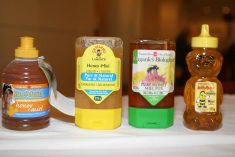STETTLER, Alta. – Sheep may not be able to open up the medicine cabinet on their own, but they do know what plants to nibble to ease their stomach aches and nutritional deficiencies.
An American study introduced sheep to three illnesses: grain acidosis, too much tannin and too much oxalate. The sheep were also given the choice of different medications to ease their illness and they all chose the correct one, said Beth Burritt, a specialist in grazing behaviour from Utah State University.
“In all cases, when offered choice the sheep learned to take their own medication.
Read Also

First annual Ag in Motion Junior Cattle Show kicks off with a bang
Ag in Motion 2025 had its first annual junior cattle show on July 15. The show hosted more than 20…
“They knew which ones cured their illness. They could pick the right medicine.”
Sheep can also use trial and error to learn which foods contain toxins and which ones contain the nutrients their bodies need to stay healthy, Burritt told a grazing symposium hosted by the Battle River Research Group.
A lot of woody plants and forbs are high in toxins but not harmful to animals when eaten in small quantities.
“Animals are good at figuring out the levels of toxins in feed,” Burritt said.
Poisoning occurs mostly when sheep are moved to a new location with unfamiliar food sources and must figure out which plants are edible.
It occurs less if the sheep have supplementary feed to lower the toxic concentrations of their diets.
“Our general recommendation is to provide a variety and let your animals choose.”
Burritt said youth, appetite and inadequate diets are the three main factors that will change how a sheep eats. Young female animals are more willing to try new food and eventually the rest of the flock mimics those behaviours and food choices.
Animals that are fed the same diet every day will go looking for new food that offers them a variety of tastes and flavours.
Animals with nutritional deficiencies will do the same to correct the deficiencies in their diet.
“Animals don’t eat to prevent deficiencies,” Burritt said. “They eat to correct deficiencies.”
Burritt said an American study showed nutrient-deficient goats ate wood rat houses because the wood was soaked in nitrogen-rich rat urine.
“Animals with deficiencies will sample. If they like it and it helps their deficiency, they will start to prefer it.”
Alberta veterinarian Dr. Kathy Parker said she watched in shock as her ewe lambs started to get a taste for lamb’s tails.
“They were chewing the tails off lambs three days old,” Parker said at the symposium.
Parker had previously taken away all the minerals because of a nutrient imbalance problem. The ewes stopped eating tails when she returned the salt.
















